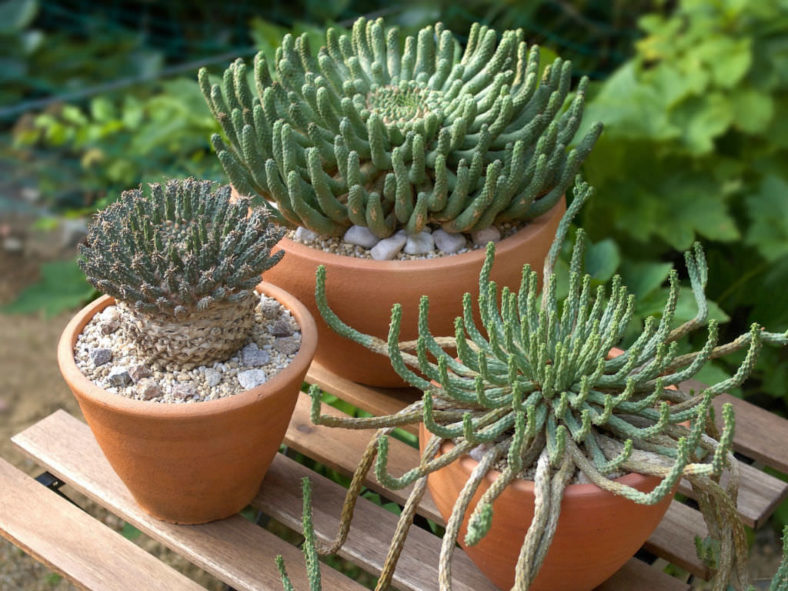The genus Euphorbia is huge and has a bewildering array of forms, including annuals and perennials, giants, and tiny ones. Because of their shape, members of one unique and fascinating group are known as Medusoid Euphorbias.
Medusoid Euphorbias are easily identified. Like Medusa in Greek mythology, they have a central head sprouting numerous snake-like arms (branches). The arms may be stubby, widely spaced or long, snake-like, and closely spaced. The central thickened stem is equivalent to a caudex for all Medusoid Euphorbias. It is the central storage region and can act as a reservoir for nutrients and moisture during stress. Many Medusoid Euphorbias shed their arms during extended droughts, regrowing new ones when the rains return.
Medusoid Euphorbias come from a wide range of habitats, with Cape Province in South Africa being Medusoid Euphorbias central, but all go through extended periods of low moisture. Cultivation for many is relatively easy, as long as attention is paid to not watering during dormancy periods. There are generally two periods of dormancy: a long one during the late fall and winter and a shorter one during the peak of the summer heat. The arrival of the summer one is harder to predict, and over-watering in late summer can result in root rot.

It is nearly impossible to find seeds for most of the Medusoid Euphorbias. In general, the seeds are short-lived. Vegetative propagation is easier. Most Medusoid Euphorbias can be propagated from arm cuttings, although an extended period will be required before the plant is worth showing.
Euphorbia arida occurs in the Northern Cape and Free State and is uncommon. It forms a relatively tall caudex up to 1 foot (30 cm), covered with short, relatively thin arms.
Euphorbia caput-medusae is a classic species from Cape Province. Its caudex can be up to 8 inches (20 cm) in diameter, and its branches are long and serpentine. It is the most snake-like of all the species.
Euphorbia crassipes is a pretty small species native to the Karoo Region of South Africa. It has thick but short arms and a caudex up to 6 inches (15 cm) in diameter.
Euphorbia decepta is from Cape Province, South Africa. The caudex is up to 4 inches (10 cm) in diameter, and the branches are generally less than an inch (2.5 cm) long. In habitat, the branches are deciduous, but they stay on the plant all year in cultivation.
Euphorbia esculenta is one of the most ornamental classic Medusoid Euphorbias with smooth, thick, pale-green arching arms. The caudex is usually mostly below ground, but most raise it for ornamental reasons in cultivation. It is native to Cape Province.
Euphorbia flanaganii is one of the most common and easily grown Medusoid Euphorbias. The central caudex is generally 2 or 3 inches (5 or 7.5 cm) across. It grows quickly, offsets readily, and can rapidly fill a large bowl.
Euphorbia fortuita comes from Cape Province. It has a tuberous main root that merges into the main caudex and stiff cylindrical branches, usually about 4 inches (10 cm) long, but occasionally one will be twice as long.
Euphorbia fusca will produce secondary heads quickly. These can be removed to start new plants.
Euphorbia gamkensis is very rare and only occurs between Calitzdorp and Oudtshoorn in the Little Karoo. It has a large, more or less cylindrical underground caudex up to 2.4 inches (6 cm) in diameter.
Euphorbia gorgonis is another species from Cape Province. The caudex is mostly subterranean. It has short tuberculate branches that turn red in intense light.
Euphorbia inermis looks like Euphorbia esculenta, with numerous thick, closely spaced arms. The caudex is up to 20 inches (50 cm) in diameter, with dozens of short arms arising from the sides.
Euphorbia inermis var. huttonae, formerly known as Euphorbia huttoniae, is a local or morphological form of Euphorbia inermis, differing only by flower character.
Euphorbia procumbens, also known as Euphorbia pugniformis, is a dwarf spineless Medusoid Euphorbia that, in its normal form, has 2 to 3 rows of lateral shoots around the deepened tip of a swollen succulent base. It is closely related to Euphorbia gorgonis and can be confused with Euphorbia flanaganii, but it is smaller.
True Medusoid Euphorbias all have a central stem in addition to their roots. Examples of Medusoid-like Euphorbias that do not have true caudex stems are Euphorbia knuthii, Euphorbia micrantha, Euphorbia hamata, Euphorbia squarrosas, and Euphorbia stellata. Euphorbia cylindrifolia and Euphorbia decaryi are sometimes included in the Medusoid Euphorbias as they have succulent stems and long, snaky arms. Still, the stems in these two species are not usually considered truly caudiciform.
Source: csssn.org
Links
- Back to genus Euphorbia
- Succupedia: Browse succulents by Scientific Name, Common Name, Genus, Family, USDA Hardiness Zone, Origin, or cacti by Genus